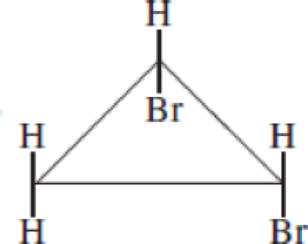
Chemistry
12th Edition
ISBN: 9780078021510
Author: Raymond Chang Dr., Kenneth Goldsby Professor
Publisher: McGraw-Hill Education
expand_more
expand_more
format_list_bulleted
Concept explainers
Textbook Question
Chapter 24, Problem 24.56QP
Indicate the asymmetric carbon atoms in the following compounds:


Expert Solution & Answer
Want to see the full answer?
Check out a sample textbook solution
Students have asked these similar questions
Topic: Photochemistry and Photophysics of Supramolecules
Two cations that exchange an electron in an interface, the exchange density is worth 1.39 mA/cm2 and the current density is worth 15 mA/cm2 at 25°C. If the overvoltage is 0.14 V, calculate the reaction rate and symmetry factor. Data: R = 8,314 J mol-1 k-1: F = 96500 C
With the help of the Tafel line, it is estimated that the interchange density of the VO2+/VO2+ system on the carbon paper has a value of 3 mA cm-2. Calculate a) the current density if the voltage has a value of 1.6 mV and the temperature is 25°C. b) the beta value of the anódico process if the Tafel pendulum is 0.6 V at 25°C. Data: R = 8.314 JK-1mol-1, y F = 96485 C mol-1.
Chapter 24 Solutions
Chemistry
Ch. 24.2 - How many structural isomers are there in the...Ch. 24.2 - Prob. 2PECh. 24.2 - Prob. 3PECh. 24.2 - Prob. 4PECh. 24.4 - Prob. 5PECh. 24 - Prob. 24.1QPCh. 24 - Prob. 24.2QPCh. 24 - What do saturated and unsaturated mean when...Ch. 24 - Prob. 24.4QPCh. 24 - Prob. 24.5QP
Ch. 24 - Why is it that alkanes and alkynes, unlike...Ch. 24 - Prob. 24.7QPCh. 24 - Prob. 24.8QPCh. 24 - Prob. 24.9QPCh. 24 - Give examples of a chiral substituted alkane and...Ch. 24 - Draw all possible structural isomers for the...Ch. 24 - Prob. 24.12QPCh. 24 - Draw all possible isomers for the molecule C4H8.Ch. 24 - Draw all possible isomers for the molecule C3H5Br.Ch. 24 - Prob. 24.15QPCh. 24 - Prob. 24.16QPCh. 24 - Draw the structures of cis-2-butene and...Ch. 24 - Prob. 24.18QPCh. 24 - Prob. 24.19QPCh. 24 - Prob. 24.20QPCh. 24 - Prob. 24.21QPCh. 24 - Prob. 24.22QPCh. 24 - Prob. 24.23QPCh. 24 - Prob. 24.24QPCh. 24 - Which of the following amino acids are chiral: (a)...Ch. 24 - Name the following compounds: (a) CH3CCCH2CH3Ch. 24 - Prob. 24.27QPCh. 24 - Prob. 24.28QPCh. 24 - Prob. 24.29QPCh. 24 - Prob. 24.30QPCh. 24 - Prob. 24.31QPCh. 24 - Name the following compounds:Ch. 24 - Prob. 24.33QPCh. 24 - Prob. 24.34QPCh. 24 - Prob. 24.35QPCh. 24 - Prob. 24.36QPCh. 24 - Prob. 24.37QPCh. 24 - Prob. 24.38QPCh. 24 - Prob. 24.39QPCh. 24 - Prob. 24.40QPCh. 24 - Predict the product or products of each of the...Ch. 24 - Prob. 24.42QPCh. 24 - Prob. 24.43QPCh. 24 - Given these data...Ch. 24 - Prob. 24.45QPCh. 24 - Prob. 24.46QPCh. 24 - Prob. 24.47QPCh. 24 - Prob. 24.48QPCh. 24 - How many liters of air (78 percent N2, 22 percent...Ch. 24 - Prob. 24.50QPCh. 24 - Prob. 24.51QPCh. 24 - Prob. 24.52QPCh. 24 - Prob. 24.53QPCh. 24 - The combustion of 3.795 mg of liquid B, which...Ch. 24 - Prob. 24.55QPCh. 24 - Indicate the asymmetric carbon atoms in the...Ch. 24 - Prob. 24.57QPCh. 24 - Prob. 24.58QPCh. 24 - Prob. 24.59QPCh. 24 - Name the classes to which the following compounds...Ch. 24 - Prob. 24.61QPCh. 24 - Prob. 24.62QPCh. 24 - Prob. 24.63QPCh. 24 - Prob. 24.64QPCh. 24 - Prob. 24.65QPCh. 24 - Prob. 24.66QPCh. 24 - Prob. 24.67QPCh. 24 - When a mixture of methane and bromine vapor is...Ch. 24 - Prob. 24.69QPCh. 24 - Prob. 24.70QPCh. 24 - Prob. 24.71QPCh. 24 - Prob. 24.72QPCh. 24 - Prob. 24.73QPCh. 24 - Prob. 24.74QP
Knowledge Booster
Learn more about
Need a deep-dive on the concept behind this application? Look no further. Learn more about this topic, chemistry and related others by exploring similar questions and additional content below.Similar questions
- Hi can you please help me solve this problem? thank youarrow_forwardAn electrode process takes place at a metal-solution interface. Indicate the current condition that must be met for Faradaic rectification to occur.arrow_forwardAt a metal-solution interface, an electron is exchanged, and the symmetry factor beta < 0.5 is found in the Butler-Volmer equation. What does this indicate?arrow_forward
arrow_back_ios
SEE MORE QUESTIONS
arrow_forward_ios
Recommended textbooks for you
 Chemistry: Principles and PracticeChemistryISBN:9780534420123Author:Daniel L. Reger, Scott R. Goode, David W. Ball, Edward MercerPublisher:Cengage Learning
Chemistry: Principles and PracticeChemistryISBN:9780534420123Author:Daniel L. Reger, Scott R. Goode, David W. Ball, Edward MercerPublisher:Cengage Learning Chemistry by OpenStax (2015-05-04)ChemistryISBN:9781938168390Author:Klaus Theopold, Richard H Langley, Paul Flowers, William R. Robinson, Mark BlaserPublisher:OpenStax
Chemistry by OpenStax (2015-05-04)ChemistryISBN:9781938168390Author:Klaus Theopold, Richard H Langley, Paul Flowers, William R. Robinson, Mark BlaserPublisher:OpenStax Chemistry: Principles and ReactionsChemistryISBN:9781305079373Author:William L. Masterton, Cecile N. HurleyPublisher:Cengage Learning
Chemistry: Principles and ReactionsChemistryISBN:9781305079373Author:William L. Masterton, Cecile N. HurleyPublisher:Cengage Learning Chemistry & Chemical ReactivityChemistryISBN:9781337399074Author:John C. Kotz, Paul M. Treichel, John Townsend, David TreichelPublisher:Cengage Learning
Chemistry & Chemical ReactivityChemistryISBN:9781337399074Author:John C. Kotz, Paul M. Treichel, John Townsend, David TreichelPublisher:Cengage Learning Chemistry & Chemical ReactivityChemistryISBN:9781133949640Author:John C. Kotz, Paul M. Treichel, John Townsend, David TreichelPublisher:Cengage Learning
Chemistry & Chemical ReactivityChemistryISBN:9781133949640Author:John C. Kotz, Paul M. Treichel, John Townsend, David TreichelPublisher:Cengage Learning Introductory Chemistry: An Active Learning Approa...ChemistryISBN:9781305079250Author:Mark S. Cracolice, Ed PetersPublisher:Cengage Learning
Introductory Chemistry: An Active Learning Approa...ChemistryISBN:9781305079250Author:Mark S. Cracolice, Ed PetersPublisher:Cengage Learning

Chemistry: Principles and Practice
Chemistry
ISBN:9780534420123
Author:Daniel L. Reger, Scott R. Goode, David W. Ball, Edward Mercer
Publisher:Cengage Learning

Chemistry by OpenStax (2015-05-04)
Chemistry
ISBN:9781938168390
Author:Klaus Theopold, Richard H Langley, Paul Flowers, William R. Robinson, Mark Blaser
Publisher:OpenStax

Chemistry: Principles and Reactions
Chemistry
ISBN:9781305079373
Author:William L. Masterton, Cecile N. Hurley
Publisher:Cengage Learning

Chemistry & Chemical Reactivity
Chemistry
ISBN:9781337399074
Author:John C. Kotz, Paul M. Treichel, John Townsend, David Treichel
Publisher:Cengage Learning

Chemistry & Chemical Reactivity
Chemistry
ISBN:9781133949640
Author:John C. Kotz, Paul M. Treichel, John Townsend, David Treichel
Publisher:Cengage Learning

Introductory Chemistry: An Active Learning Approa...
Chemistry
ISBN:9781305079250
Author:Mark S. Cracolice, Ed Peters
Publisher:Cengage Learning
Lipids - Fatty Acids, Triglycerides, Phospholipids, Terpenes, Waxes, Eicosanoids; Author: The Organic Chemistry Tutor;https://www.youtube.com/watch?v=7dmoH5dAvpY;License: Standard YouTube License, CC-BY